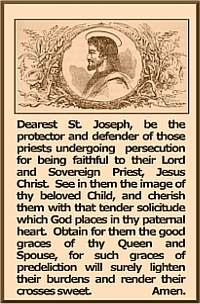 The priest reads the Communion Antiphon from the Epistle side, after which he turns to the faithful with the penultimate Dominus Vobiscum. The antiphon, a prayer of thanksgiving, is very simple and brief. Holy Mother Church recognizes that the faithful enjoy the liberty of the Children of God, and thus She allows them to make their own thanksgiving according to their individual fervor and personal piety.
The priest reads the Communion Antiphon from the Epistle side, after which he turns to the faithful with the penultimate Dominus Vobiscum. The antiphon, a prayer of thanksgiving, is very simple and brief. Holy Mother Church recognizes that the faithful enjoy the liberty of the Children of God, and thus She allows them to make their own thanksgiving according to their individual fervor and personal piety.
In Holy Communion, Fr. Ghir writes: “…we receive[ed] Christ’s Body and Blood into our heart, that is, we are not merely by faith, charity and grace united spiritually, but also corporally with Christ and, in consequence thereof, in a more perfect sense we become members of the Body of Christ, bone of His bone and flesh of His flesh, as it were, one body and one blood with Christ. [T]he personality of the devout communicant is elevated and ennobled, consecrated and sanctified, Christ cherishes, loves and esteems it, thus to speak, as His own, for it is in a special manner espoused to and possessed by Him. This aspect gives a new claim to the glorification of the body at the general resurrection.”
It is a praiseworthy recommendation that the faithful spend time after Mass to quietly express their gratitude to God.
Prayer (from the Imitation of Christ): “O most sweet Lord Jesus, how great is the blessedness of the devout soul that feedeth with Thee in Thy banquet, where there is set before it no other food than Thyself, its only Beloved, more to be desired than all the desires of the heart? And to me it would verily be sweet to pour forth my tears in Thy presence from the very bottom of my heart, and with the pious Magdalene to water Thy feet with my tears. But where is this devotion? Where the abundant flowing of holy tears? Surely in Thy presence and in the presence of the holy Angels my whole heart ought to burn and to weep for joy; for I have Thee in the Sacrament verily present, although hidden under other form.”
___________________
Most commonly, in the N.O. there is no Communion Antiphon since the Communion hymn typically replaces this prayer. The Communion hymn can be something as secular and baneful as “Let There be Peace on Earth”, as was done this past May for a First Communion in an area church.
There are priests who will at this time, sit down for moments of silent prayer. Since it is a period of contrived stillness in contrast to the noisiness and activity of the rest of the liturgy, and there is an inescapable, necessary compliance by the congregation to also sit quietly, this silence is awkward in its artificiality, but not surprising in a liturgy which has been “manufactured”.
Also, consider that a “thanksgiving” after Mass is practically impossible due to the commotion and loud clamoring of numerous congregants who like to visit with one another in the church.



